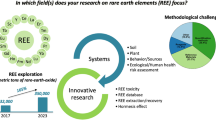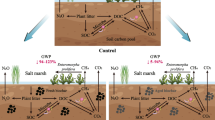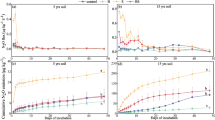Abstract
Purpose
Nanoparticles released into soil environment potentially impact microorganisms, which furtherly disturb terrestrial biogeochemical cycles. However, how rare earth oxide nanoparticles affect the functional microorganisms inhabited in natural soil is still unknown. This study was aimed to investigate the effect of different types of rare earth oxide nanoparticles on the ammonia-oxidizing microorganisms.
Materials and methods
Soil respectively added with 0, 10, 50, and 100 mg kg−1 of La2O3, Nd2O3, or Gd2O3 nanoparticle were incubated at 25 °C in the dark for 60 days. The potential ammonia oxidation (PAO), abundance and communities of ammonia-oxidizing archaea (AOA), and ammonia-oxidizing bacteria (AOB) were measured at the 1st, 7th, and 60th day.
Results and discussion
Our results showed that the PAO in soils with nanoparticles significantly decreased due to nanoparticle toxicity at the 1st day, but it gradually increased to the control level owing to the adaptation of AOA and AOB in soils with nano-Nd2O3 and nano-Gd2O3. Interestingly, the abundance of AOB as reflected by the qPCR analysis was upregulated for the hormesis effect of AOB responding to nano-Nd2O3 or nano-Gd2O3 with 50 mg kg−1 level. Moreover, terminal restriction fragment length polymorphism (T-RFLP) results suggested that the communities for AOA and AOB shifted with nanoparticles type and incubation time.
Conclusions
Rare earth oxide nanoparticles could inhibit activities of ammonia-oxidizing microorganisms, and thus they might be used as potential nitrification inhibitors to improve nitrogen use efficiency in the agricultural ecosystems.




Similar content being viewed by others
References
Ahmad HR, Zia-ur-Rehman M, Sohail MI, ul Haq MA, Khalid H, Ayub MA, Ishaq G (2018) Effects of rare earth oxide nanoparticles on plants. In: Nanomaterials in plants, algae, and microorganisms. Academic Press, Pittsburgh, pp 239–275
Ali J, Ali N, Wang L, Waseem H, Pan G (2019) Revisiting the mechanistic pathways for bacterial mediated synthesis of noble metal nanoparticles. J Microbiol Methods 159:18–25
Aydın A, Sipahi H, Mohammad C (2012) Nanoparticles toxicity and their routes of exposures. In: Recent advances in novel drug carrier systems, pp 483–500
Carini P, Marsden PJ, Leff JW, Morgan EE, Strickland MS, Fierer N (2016) Relic DNA is abundant in soil and obscures estimates of soil microbial diversity. Nat Microbiol 2:16242
de Scally SZ, Makhalanyane TP, Frossard A, Hogg ID, Cowan DA (2016) Antarctic microbial communities are functionally redundant, adapted and resistant to short term temperature perturbations. Soil Biol Biochem 103:160–170
Dhand C, Dwivedi N, Loh XJ, Ying ANJ, Verma NK, Beuerman RW, Lakshminarayanan R, Ramakrishna S (2015) Methods and strategies for the synthesis of diverse nanoparticles and their applications: a comprehensive overview. RSC Adv 5:105003–105037
Forsberg KJ, Patel S, Gibson MK, Lauber CL, Knight R, Fierer N, Dantas G (2014) Bacterial phylogeny structures soil resistomes across habitats. Nature 509(7502):612–616
Francis CA, Roberts KJ, Beman JM, Santoro AE, Oakley BB (2005) Ubiquity and diversity of ammonia-oxidizing archaea in water columns and sediments of the ocean. Proc Natl Acad Sci U S A 102:14683–14688
Galand PE, Pereira O, Hochart C, Auguet JC, Debroas D (2018) A strong link between marine microbial community composition and function challenges the idea of functional redundancy. ISME J 12:2470–2478
Ge Y, Schimel JP, Holden PA (2011) Evidence for negative effects of TiO2 and ZnO nanoparticles on soil bacterial communities. Environ Sci Technol 45:1659–1664
Ge Y, Priester JH, Van De Werfhorst LC, Walker SL, Nisbet RM, An Y, Schimel JP, Gardea-Torresdey JL, Holden PA (2014) Soybean plants modify metal oxide nanoparticle effects on soil bacterial communities. Environ Sci Technol 48(22):13489–13496
Ge Y, Horst AM, Kim J, Priester JH, Welch ZS, Holden PA (2016a) Toxicity of manufactured nanomaterials to microorganisms. In: Senesi N, Xing B (eds) Toxicity of engineered nanoparticles and risk assessment. Wiley, Hoboken, pp 320–346
Ge Y, Priester JH, Mortimer M, Chang CH, Ji Z, Schimel JP, Holden PA (2016b) Long-term effects of multiwalled carbon nanotubes and graphene on microbial communities in dry soil. Environ Sci Technol 50:3965–3974
Ge Y, Shen C, Wang Y, Sun Y, Schimel JP, Gardea-Torresdey JL, Holden PA (2018) Carbonaceous nanomaterials have higher effects on soybean rhizosphere prokaryotic communities during the reproductive growth phase than during vegetative growth. Environ Sci Technol 52:6636–6646
Grün A-L, Manz W, Kohl YL, Meier F, Straskraba S, Jost C, Drexel R, Emmerling C (2019) Impact of silver nanoparticles (AgNP) on soil microbial community depending on functionalization, concentration, exposure time, and soil texture. Environ Sci Eur 31:15
Gustave W, Yuan Z, Sekar R, Toppin V, Liu J, Ren Y, Zhang J, Chen Z (2019) Relic DNA does not obscure the microbial community of paddy soil microbial fuel cells. Res Microbiol 170:97–104
He S, Feng Y, Ni J, Sun Y, Xue L, Feng Y, Yu Y, Lin X, Yang L (2016) Different responses of soil microbial metabolic activity to silver and iron oxide nanoparticles. Chemosphere 147:195–202
Hink L, Gubry-Rangin C, Nicol GW, Prosser JI (2018) The consequences of niche and physiological differentiation of archaeal and bacterial ammonia oxidisers for nitrous oxide emissions. ISME J 12:1084–1093
Hu H-W, He J-Z (2017) Comammox-a newly discovered nitrification process in the terrestrial nitrogen cycle. J Soils Sediments 17:2709–2717
Kurola J, Salkinoja-Salonen M, Aarnio T, Hultman J, Romantschuk M (2005) Activity, diversity and population size of ammonia-oxidising bacteria in oil-contaminated landfarming soil. FEMS Microbiol Lett 250:33–38
Lennon JT, Muscarella ME, Placella SA, Lehmkuhla BK (2018) How, when, and where relic DNA affects microbial diversity. ASM 9(3):e00637–e00618
Li Y, Chapman SJ, Nicol GW, Yao H (2018) Nitrification and nitrifiers in acidic soils. Soil Biol Biochem 116:290–301
Li Y, Chen Z, He J, Wang Q, Shen C, Ge Y (2019a) Ectomycorrhizal fungi inoculation alleviates simulated acid rain effects on soil ammonia oxidisers and denitrifiers in Masson pine forest. Environ Microbiol 21(1):299–313
Li Y, Xi R, Wang W, Yao H (2019b) The relative contribution of nitrifiers to autotrophic nitrification across a pH-gradient in a vegetable cropped soil. J Soils Sediments 19:1416–1426
Ma Y, Kuang L, He X, Bai W, Ding Y, Zhang Z, Zhao Y, Chai Z (2010) Effects of rare earth oxide nanoparticles on root elongation of plants. Chemosphere 78:273–279
Moeinzadeh S, Jabbari E (2018) Nanoparticles and their applications. In: Bhushan B (ed) Springer handbook of nanotechnology, 4th edn. Springer, Berlin, pp 335–361
Moore JD, Stegemeier JP, Bibby K, Marinakos SM, Lowry GV, Gregory KB (2016) Impacts of pristine and transformed Ag and Cu engineered nanomaterials on surficial sediment microbial communities appear short-lived. Environ Sci Technol 50:2641–2651
Nichol D, Rutter J, Bryant C, Hujer AM, Lek S, Adams MD, Jeavons P, Anderson ARA, Bonomo RA, Scott JG (2019) Antibiotic collateral sensitivity is contingent on the repeatability of evolution. Nat Commun 10:334
Oliver TH, Isaac NJB, August TA, Woodcock BA, Roy DB, Bullock JM (2015) Declining resilience of ecosystem functions under biodiversity loss. Nat Commun 6:10122
Prosser JI, Nicol GW (2012) Archaeal and bacterial ammoniaoxidisers in soil: the quest for niche specialisation and differentiation. Trends Microbiol 20(11):523–531
Qi L, Ge Y, Xia T, He J, Shen C, Wang J, Liu Y (2019) Rare earth oxide nanoparticles promote soil microbial antibiotic resistance by selectively enriching antibiotic resistance genes. Environ Sci-Nano 6:456–466
Rashid MI, Shahzad T, Shahid M, Ismail IMI, Shah GM, Almeelbi T (2017) Zinc oxide nanoparticles affect carbon and nitrogen mineralization of Phoenix dactylifera leaf litter in a sandy soil. J Hazard Mater 324:298–305
Reichardt N, Vollmer M, Holtrop G, Farquharson FM, Wefers D, Bunzel M, Duncan SH, Drew JE, Williams LM, Milligan G, Preston T, Morrison D, Flint HJ, Louis P (2018) Specific substrate-driven changes in human faecal microbiota composition contrast with functional redundancy in short-chain fatty acid production. ISME J 12:610–622
Ren L, Cai C, Zhang J, Yang Y, Wu G, Luo L, Huang H, Zhou Y, Qin P, Yu M (2018) Key environmental factors to variation of ammonia-oxidizing archaea community and potential ammonia oxidation rate during agricultural waste composting. Bioresour Technol 270:278–285
Rotthauwe JH, Witzel KP, Liesack W (1997) The ammonia monooxygenase structural gene amoA as a functional marker: molecular fine-scale analysis of natural ammonia-oxidizing populations. Appl Environ Microbiol 63:4704–4712
Šantrůčková H, Kotas P, Bárta J, Urich T, Čapek P, Palmtag J, Alves RJE, Biasi C, Diáková K, Gentsch N, Gittel A, Guggenberger G, Hugelius G, Lashchinsky N, Martikainen PJ, Mikutta R, Schleper C, Schnecker J, Schwab C, Shibistova O, Wild B, Richter A (2018) Significance of dark CO2 fixation in arctic soils. Soil Biol Biochem 119:11–21
Sepehri A, Sarrafzadeh M-H (2019) Activity enhancement of ammonia-oxidizing bacteria and nitrite-oxidizing bacteria in activated sludge process: metabolite reduction and CO2 mitigation intensification process. Appl Water Sci 9:131
Shade A, Peter H, Allison SD, Baho DL, Berga M, Bürgmann H, Huber DH, Langenheder S, Lennon JT, Martiny JBH, Matulich KL, Schmidt TM, Handelsman J (2012) Fundamentals of microbial community resistance and resilience. Front Microbiol 3:417
Srivastava V, Gusain D, Sharma YC (2015) Critical review on the toxicity of some widely used engineered nanoparticles. Ind Eng Chem Res 54:6209–6233
Sun R, Myrold DD, Wang D, Guo X, Chu H (2019) AOA and AOB communities respond differently to changes of soil pH under long-term fertilization. Soil Ecol Lett 1(3–4):126–135
Tang J, Wu Y, Esquivel-Elizondo S, Sørensen SJ, Rittmann BE (2018) How microbial aggregates protect against nanoparticle toxicity. Trends Biotechnol 36(11):1171–1182
Wang J, Wang J, Rhodes G, He J, Ge Y (2019) Adaptive responses of comammox Nitrospira and canonical ammonia oxidizers to long-term fertilizations: implications for the relative contributions of different ammonia oxidizers to soil nitrogen cycling. Sci Total Environ 668:224–233
Xiang SR, Doyle A, Holden PA, Schimel JP (2008) Drying and rewetting effects on C and N mineralization and microbial activity in surface and subsurface California grassland soils. Soil Biol Biochem 40:2281–2289
Xu C, Peng C, Sun L, Zhang S, Huang H, Chen Y, Shi J (2015) Distinctive effects of TiO2 and CuO nanoparticles on soil microbes and their community structures in flooded paddy soil. Soil Biol Biochem 86:24–33
Yue L, Chen F, Yu K, Xiao Z, Yu X, Wang Z, Xing B (2019) Early development of apoplastic barriers and molecular mechanisms in juvenile maize roots in response to La2O3 nanoparticles. Sci Total Environ 653:675–683
Zhang L, Hu H, Shen J, He J (2012) Ammonia-oxidizing archaea have more important role than ammonia-oxidizing bacteria in ammonia oxidation of strongly acidic soils. ISME J 6:1032–1045
Zhang H, Sun H, Zhou S, Bai N, Zheng X, Li S, Zhang J, Lv W (2019a) Effect of straw and straw biochar on the community structure and diversity of ammonia-oxidizing bacteria and archaea in rice-wheat rotation ecosystems. Sci Rep 9:9367
Zhang Q, Li Y, He Y, Brookes PC, Xu J (2019b) Elevated temperature increased nitrification activity by stimulating AOB growth and activity in an acidic paddy soil. Plant Soil 445:71–83
Funding
This work was supported by the National Natural Science Foundation of China (41671254), the National Postdoctoral Program for Innovative Talents (BX201700273), and the State Key Laboratory of Urban and Regional Ecology (SKLURE2017-1-7).
Author information
Authors and Affiliations
Corresponding author
Ethics declarations
Conflict of interest
The authors declare that they have no conflict of interest.
Research involving human participants and/or animals
This article does not contain any studies with human participants or animals performed by any of the authors.
Informed consent
This manuscript is new and not being considered elsewhere. All authors have approved the submission of this manuscript.
Additional information
Responsible editor: Huaiying Yao
Publisher’s note
Springer Nature remains neutral with regard to jurisdictional claims in published maps and institutional affiliations.
Rights and permissions
About this article
Cite this article
Yue, Y., Qi, L., Li, Y. et al. Negative effects of rare earth oxide nanoparticles of La2O3, Nd2O3, and Gd2O3 on the ammonia-oxidizing microorganisms. J Soils Sediments 20, 3114–3123 (2020). https://doi.org/10.1007/s11368-020-02627-x
Received:
Accepted:
Published:
Issue Date:
DOI: https://doi.org/10.1007/s11368-020-02627-x




